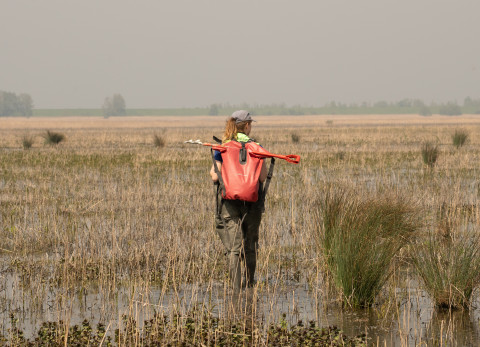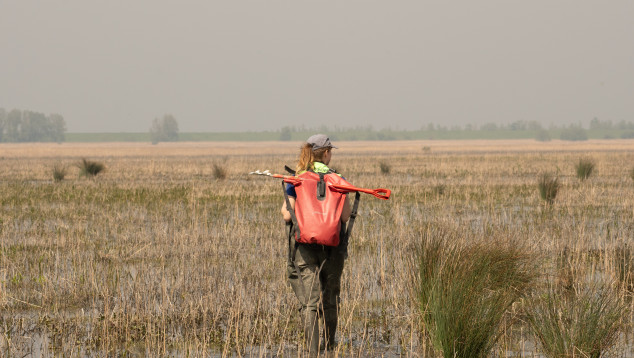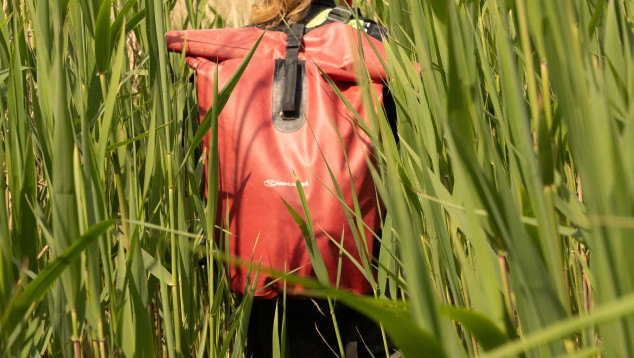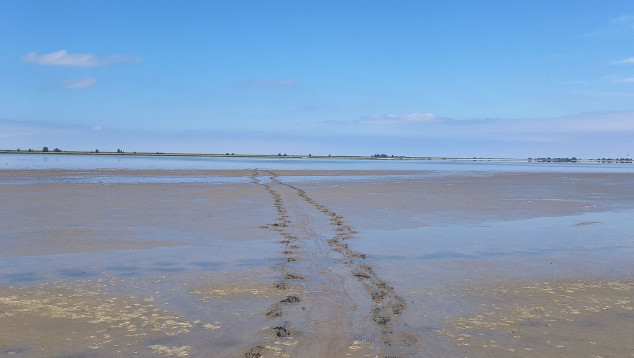Up and down the marshes

Up and down the marshes
Press inquiries
Lower the water level in a marsh temporarily and you get a more resilient, healthy and biodiverse ecosystem in return. That is the advice of ecologist Kerstin Bouma and her colleagues at the Netherlands Institute of Ecology (NIOO-KNAW). An extraordinary opportunity presented itself in the Oostvaardersplassen to find out how this works. She defended her PhD on that research in the mud and among the reeds on Friday 4 April.
How does a variety in water levels boost the biodiversity in marshes? Until now, we did know that dikes and dams reduce the dynamics in a marsh, and consequently the diversity of birds, for example. But we did not yet know exactly why. Kerstin Bouma's PhD research is now changing that.
Over and over again
The nutrient-rich clay marshes of Oostvaardersplassen provided an ideal opportunity for the necessary experiments. In 2020, the managers lowered the water level of the western part of the marsh for a few years: this is called a “reset”. Meanwhile, the eastern part just stayed wet. Bingo: the perfect opportunity to compare. Indeed, by nature, you find “boom-and-bust” phases in such marshes with alternating dry and wet periods and therefore birds and fish that alternately increase and decrease sharply. The ecosystem actually reinvents itself all the time.
Bouma found that the water level is a driver of changes in plant growth and also determines how much food is available or accessible. Bouma: "Consider waders for example. These birds eat small animals from the sediment, but can only reach them if the water is not too deep. So it is important that the bed is not equally deep everywhere. Furthermore, large fish - in this case mainly carp - reduce the food available for the birds and make the water murkier."
Monitoring
With vegetation measurements in the field and satellite images, the researchers monitored plant developments. In some places, the vegetation was shielded from local grazers - red deer and geese in particular. And for experiments with seeds present in the sediment, they carefully brought some undisturbed soil cores from Oostvaardersplassen to the lab. Both seeds and nutrients remain sufficiently present despite all the changes in water levels and environmental conditions.
There is another important thing to note. 'You don't get an exact copy with a repetition,' Bouma explains. If you dry out a swamp again, the exact same thing that happened last time does not happen. In fact, between 1987 and 1992, the Oostvaardersplassen also underwent a complete cycle of dry and wet marsh before. With this, Bouma could nicely compare her measurements from now. Repetition does not guarantee that you get exactly the same plant species, for instance. So the details remain a surprise.
Rare and valuable
Clay marshes are relatively rare in Europe. They are known for their tremendous nutrient richness and remarkably large numbers of water and marsh birds. But the strain on these areas is growing, mainly due to humans, and this has negative consequences. So managing these ecosystems has its challenges. The research by Bouma and her colleagues is now clarifying the precise effect of varying water levels, making it possible to specifically increase biodiversity across an entire landscape. ‘This applies to both natural and human-managed wetlands’.
Marker Wadden
"You probably get the greatest variation in habitats and thus in biodiversity if the whole area is not in the same phase. Each phase, dry or wet or in between, has its own species that flourish there." So it is important to work together on a larger scale. In National Park Nieuw Land, for example, it was very good that the Oostvaardersplassen were in the open water phase, while the Marker Wadden were just welcoming the first pioneer species at that time.
__________________________________________________________________________________________
With more than 200 staff members and students, the Netherlands Institute of Ecology (NIOO-KNAW) is one of the largest research institutes of the Royal Netherlands Academy of Arts and Sciences (KNAW). The institute specialises in water and land ecology with three major themes: biodiversity, climate change and the sustainable use of land and water. Since 2011 NIOO is located in an innovative and sustainable research building in Wageningen, the Netherlands. NIOO has an impressive research history that stretches back 70 years and spans the entire country, and beyond. www.nioo.knaw.nl
More information:
- Researcher Kerstin Bouma, department of Aquatic Ecology, Netherlands Institute of Ecology (NIOO-KNAW), k.bouma@nioo.knaw.nl
- Promotor Prof. dr. Liesbeth Bakker, department of Aquatic Ecology, Netherlands Institute of Ecology (NIOO-KNAW), l.bakker@nioo.knaw.nl
- Science information officer Froukje Rienks, Netherlands Institute of Ecology (NIOO-KNAW), tel. 06-10487481 / 0317-473590, f.rienks@nioo.knaw.nl
Downloads
-
Ecoloog Kerstin Bouma loopt door de rietvelden (JPG)Ecologist Kerstin Bouma walking through reed vegetation (JPG)
-
Moeraslandschap met rietvelden en water (JPG)Marsh landscape with reed vegetation and water (JPG)
-
Moeraslandschap met rietvelden (JPG)Marsh landscape with reed vegetation (JPG)
-
Ecoloog Kerstin Bouma loopt door het moeras (JPG)Ecologist Kerstin Bouma walking through marshlands (JPG)
-
Voetstappen in de modder OostvaardersplassenFootsteps in the mud of Oostvaardersplassen (JPG)



